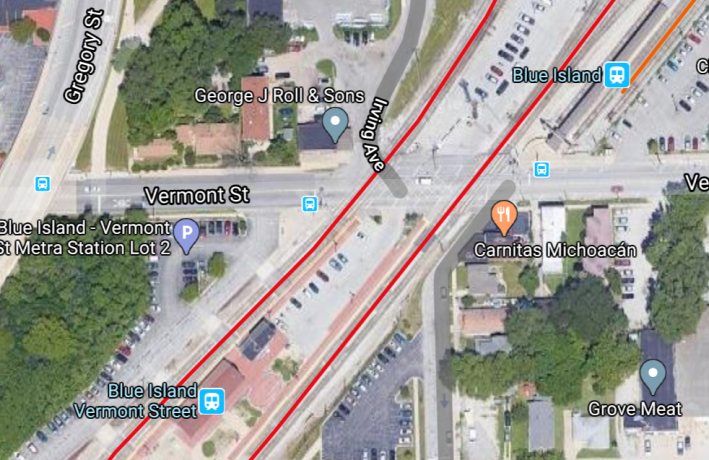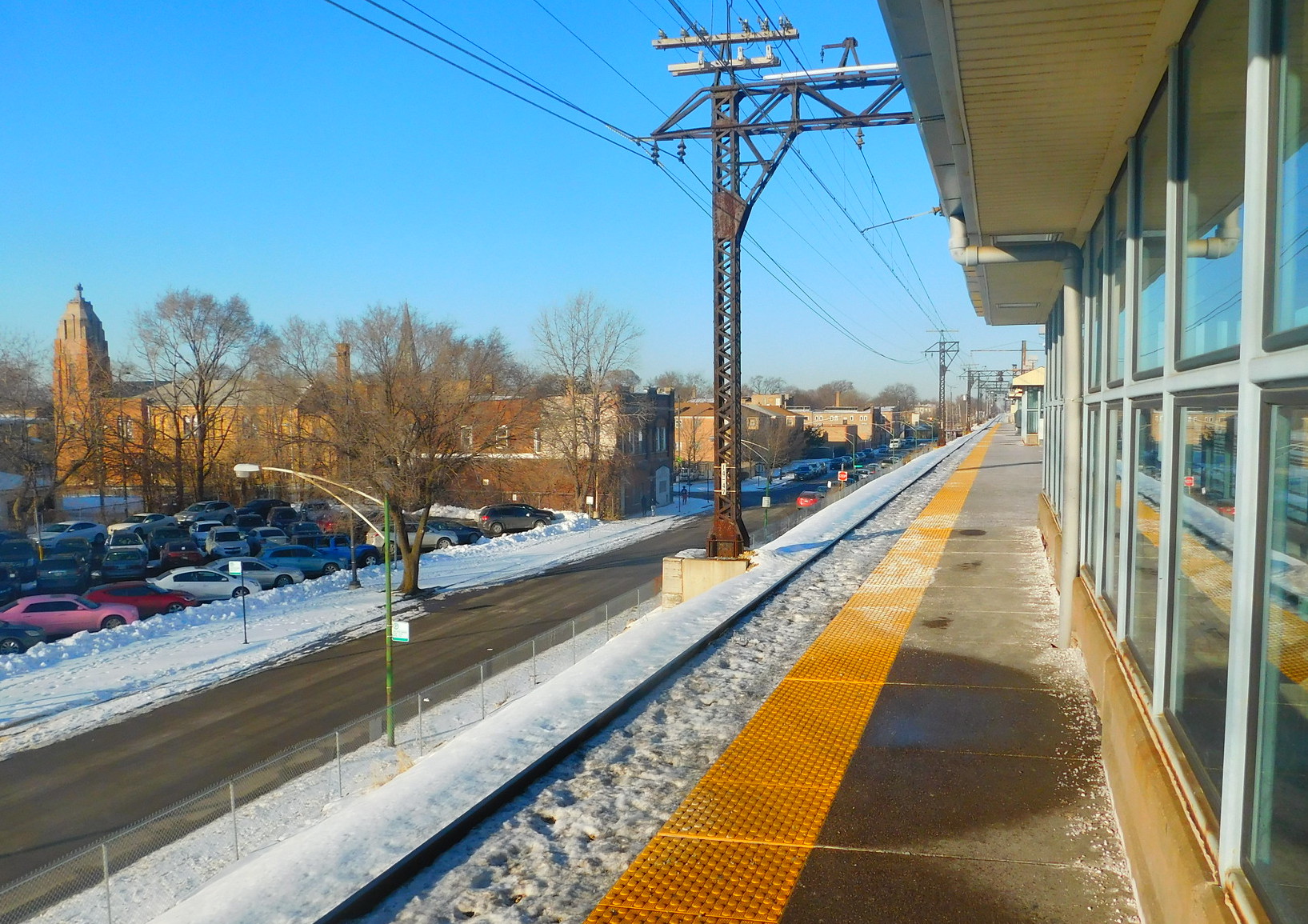As part of the process of installing the federally mandated Positive Train Control safety system, Metra needs to adjust the schedule of the Metra Electric District. The proposed changes would increase service on the South Side, but they would also adjust the set-up for rush-hour suburban express trips in a way that could increase travel times for residents of outlying south suburbs.
(Note that the planned MED schedule changes associated with PTC installation are a separate animal from the South Cook Fair Transit Pilot project, a proposal by Metra and Cook County to increase train frequency, lower fares, and reduce the price of transfers on the MED and Rock Island District lines.)
Like all other U.S. commuter rail agencies, Metra is currently in the process of implementing PTC, designed to automatically stop trains in case of an emergency in order to avoid collisions. Under the Rail Safety Improvement Act of 2008, Metra is required to add PTC on all of the “district” lines it owns outright, including the Metra Electric, as well as help cover the costs of installing it on the lines it doesn’t own. As the system has been rolled out, Metra has needed to adjust train schedules, both on- and off-peak.
For the MED line, most of the proposed adjustments involve shifting the schedules by a few minutes. But the changes would also result in a few more afternoon and evening trips, more convenient transfers and some further reduction of service along the line’s Blue Island branch, which has already seen service cuts. Metra is collecting public input until the end of February, and, if the past schedule changes on the RID and BNSF Railway lines were any indication, it may take some of those responses into account.
PTC uses a combination of GPS, trackside sensors and communications units, onboard computers, and Metra’s centralized train dispatching system to track the trains. If a train goes too fast or misses a signal, the system will kick in to stop it.
The Metra Electric stands apart from the rest of the system for several reasons. As the name suggests, it is electrically powered, so its trains don’t require separate locomotives. It is the only line in which all sections, except the branches, have four passenger rail-only tracks, which reduces scheduling conflicts between local and express trains, and eliminates conflicts with freight and Amtrak trains. It has more stations in Chicago than any other Metra line, and it is the only line that has a branch -- the South Chicago branch -- located entirely within the city limits.
As noted on Metra’s website, PTC affects how quickly trains can be turned around at terminals, which is especially noticeable during rush hours. “Under PTC, the crew of a train must initialize the system before each individual run,” it states. “This includes entering information about the size and makeup of the train (because its weight affects its stopping distance) and any other details about conditions along the route (such as work zones or speed restrictions) that could affect the safe operation of the train. The initialization process is expected to take about six minutes.”
This, in addition to other tasks the crew are already required to perform, means that it takes at least 10 minutes to “flip” the train. “On the current Metra Electric schedule, there are 51 trains scheduled to flip in less than 10 minutes, including 23 scheduled to flip in less than 6 minutes,” a Metra press release stated. “The need to initialize PTC means it will not be possible to operate the same number of trains during rush hour, and so a new schedule is needed.”
Schedule changes within Chicago
The South Chicago branch would see the most changes, at least in the evening. It would add two extra outbound evening trips -- one between the current 6:30 p.m. and 7:30 p.m. runs, and another between the 7:30 p.m. and 9:30 p.m. trips. The former would leave Millennium Station at 7 p.m. and arrive at the South Chicago/93rd Street stop at 7:37 p.m., while the later would leave at 8:30 p.m. and arrive at 9:09 p.m. And the proposed schedule change would also add two extra inbound trips and shift the schedule so that between 6:30 p.m. and 8:30 p.m. trains would leave the South Chicago/93rd Street stop once every half hour.
On the MED main line between 63rd and 115th streets, the new schedule would slightly increase rush hour service. Under the current morning schedule, some trains make all of the intermediate stops, other runs make some intermediate stops, and some trains skip the intermediate stops entirely. The revised schedule simplifies this set up, so that trains would either serve all intermediate stops or run express, serving no intermediate stops. And during the evening rush, the new schedule would add an extra local train between 4 and 5 p.m.
The Blue Island branch, which serves the Far South Side and suburban Calumet Park and Blue Island, has seen service reductions over the years, especially on Saturdays. The proposed changes are a mixed bag. The new schedule would replace the 6:38 p.m. and 7:41 p.m. inbound evening trips with a single 7:06 p.m. run. But it would also add a new outbound evening trip leaving Millennium station at 6:02 p.m. and arriving in Blue Island at 6:59.
The schedule would also be adjusted to improve transfers. Under the current set-up, the trains that make intermediate stops (which includes all Blue Island trains) and the trains that serve the suburbs pull in at the Kensington/115th Street station a few minutes apart. Under the proposed schedule, they would pull in at the same time on two different sides of the platform, allowing passengers to conveniently transfer in either direction. That's similar to how the CTA Red and Brown line trains often wait for each other at the Belmont and Fullerton transfer stations to facilitate switching between lines.

The adjustments to the Blue Island branch departures would make some transfers between that branch and the Rock Island District line more convenient. The Blue Island MED station (the southern terminus of the Blue Island branch) and the RID line's Blue Island - Vermont Street station are located across Vermont Street from each other, and under the current schedule, there are several scenarios where the riders only have two minutes to transfer between lines. The proposed changes to the Blue Island schedule would double that time to four minutes.
Schedule changes in the suburbs
Under the current system, rush-hour MED express trains follow a stair-step schedule. In the morning, the first express train starts at Harvey; the second train starts at Flossmoor and skips all the suburban stops the previous train served; the third train starts at University Park and skips the stops the previous two trains served; and so on. In the afternoon, the pattern is flipped for outbound trains.
The revised schedule would reduce the three “steps” to two, with trains starting and stopping at either University Park or Homewood. And, unlike the current schedule, the University Park trains would stop at Homewood as well, allowing transfers.
As the Metra press release acknowledges, this would mean longer travel times for riders from suburbs further south. And it admits that, since a ridership that is currently spread across three separate trains would be packed into two, the express trains would become more crowded, which is why the transit agency plans to add more cars to accommodate the additional riders.
In addition, the new schedule would add an afternoon express train that would leave Millennium Station at 1:10 p.m., skip all the stops between the Museum Campus/11th Street stop and Homewood, and arrive at University Park at 1:58 p.m.



